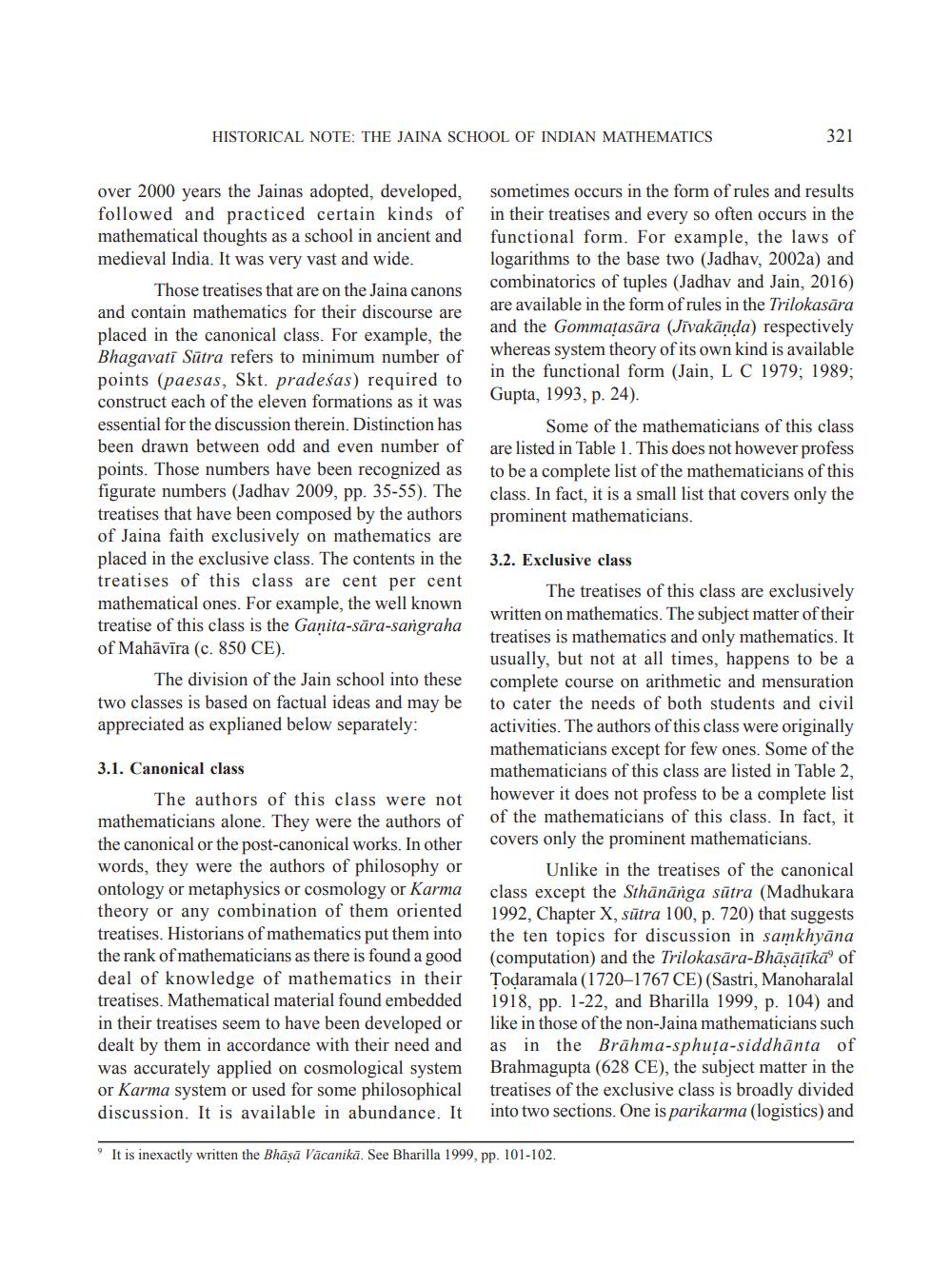________________
HISTORICAL NOTE: THE JAINA SCHOOL OF INDIAN MATHEMATICS
over 2000 years the Jainas adopted, developed, followed and practiced certain kinds of mathematical thoughts as a school in ancient and medieval India. It was very vast and wide.
Those treatises that are on the Jaina canons and contain mathematics for their discourse are placed in the canonical class. For example, the Bhagavati Sūtra refers to minimum number of points (paesas, Skt. pradeśas) required to construct each of the eleven formations as it was essential for the discussion therein. Distinction has been drawn between odd and even number of points. Those numbers have been recognized as figurate numbers (Jadhav 2009, pp. 35-55). The treatises that have been composed by the authors of Jaina faith exclusively on mathematics are placed in the exclusive class. The contents in the 3.2. Exclusive class
treatises of this class are cent per cent mathematical ones. For example, the well known treatise of this class is the Ganita-sara-sangraha of Mahāvīra (c. 850 CE).
The division of the Jain school into these two classes is based on factual ideas and may be appreciated as explianed below separately:
sometimes occurs in the form of rules and results in their treatises and every so often occurs in the functional form. For example, the laws of logarithms to the base two (Jadhav, 2002a) and combinatorics of tuples (Jadhav and Jain, 2016) are available in the form of rules in the Trilokasara and the Gommatasära (Jivakända) respectively whereas system theory of its own kind is available in the functional form (Jain, LC 1979; 1989; Gupta, 1993, p. 24).
321
Some of the mathematicians of this class are listed in Table 1. This does not however profess to be a complete list of the mathematicians of this class. In fact, it is a small list that covers only the prominent mathematicians.
The treatises of this class are exclusively treatises is mathematics and only mathematics. It written on mathematics. The subject matter of their usually, but not at all times, happens to be at complete course on arithmetic and mensuration to cater the needs of both students and civil activities. The authors of this class were originally mathematicians except for few ones. Some of the mathematicians of this class are listed in Table 2, however it does not profess to be a complete list of the mathematicians of this class. In fact, it covers only the prominent mathematicians.
3.1. Canonical class
The authors of this class were not mathematicians alone. They were the authors of the canonical or the post-canonical works. In other words, they were the authors of philosophy or ontology or metaphysics or cosmology or Karma theory or any combination of them oriented treatises. Historians of mathematics put them into the rank of mathematicians as there is found a good deal of knowledge of mathematics in their treatises. Mathematical material found embedded in their treatises seem to have been developed or dealt by them in accordance with their need and was accurately applied on cosmological system or Karma system or used for some philosophical discussion. It is available in abundance. It
9 It is inexactly written the Bhāṣā Vācanikā. See Bharilla 1999, pp. 101-102.
Unlike in the treatises of the canonical class except the Sthānanga sutra (Madhukara 1992, Chapter X, sutra 100, p. 720) that suggests the ten topics for discussion in samkhyāna (computation) and the Trilokasära-Bhāṣāṭīka of Todaramala (1720-1767 CE) (Sastri, Manoharalal 1918, pp. 1-22, and Bharilla 1999, p. 104) and like in those of the non-Jaina mathematicians such as in the Brahma-sphuța-siddhanta of Brahmagupta (628 CE), the subject matter in the treatises of the exclusive class is broadly divided into two sections. One is parikarma (logistics) and




